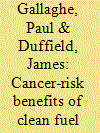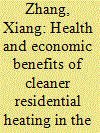|
|
|
Sort Order |
|
|
|
Items / Page
|
|
|
|
|
|
|
| Srl | Item |
| 1 |
ID:
092736


|
|
|
|
|
| Publication |
2009.
|
| Summary/Abstract |
The hypothesis of this study is that there is a statistical relationship between the lung cancer mortality rate and the intensity of fuel consumption (measured in gallons/square mile) at a particular location. We estimate cross-section regressions of the mortality rate due to lung cancer against the intensity of fuel consumption using local data for the entire US, before the US Clean Air Act (CAA) in 1974 and after the most recent policy revisions in 2004. The cancer rate improvement estimate suggests that up to 10 lung cancer deaths per 100,000 residents are avoided in the largest urban areas with highest fuel consumption per square mile. In New York City, for instance, the mortality reduction may be worth about $5.7 billion annually. Across the US, the estimated value of statistical life (VSL) benefit is $27.2 billion annually. There are likely three inseparable reasons that contributed importantly to this welfare improvement. First, the CAA regulations mandated reduction in specific carcinogenic chemicals or smog components. Second, technologies such as the catalytic converter (CC) and low-particulate diesel engine were adopted. Third, biofuels have had important roles, making the adoption of clean air technology possible and substituting for high emission fuels.
|
|
|
|
|
|
|
|
|
|
|
|
|
|
|
|
| 2 |
ID:
094406


|
|
|
|
|
| Publication |
2010.
|
| Summary/Abstract |
The hypothesis of this study is that there is a statistical relationship between the cardiovascular disease mortality rate and the intensity of fuel consumption (measured in gallons/square mile) at a particular location. We estimate cross-sectional regressions of the mortality rate due to cardiovascular disease against the intensity of fuel consumption using local data for the entire US, before the US Clean Air Act (CAA) in 1974 and after the most recent policy revisions in 2004. The cardiovascular disease rate improvement estimate suggests that up to 60 cardiovascular disease deaths per 100,000 residents are avoided in the largest urban areas with highest fuel consumption per square mile. In New York City, for instance, the mortality reduction may be worth about $30.3 billion annually. Across the US, the estimated Value of Statistical Life (VSL) benefit is $202.7 billion annually. There are likely three inseparable reasons that contributed importantly to this welfare improvement. First, the CAA regulations banned leaded gasoline, and mandated reduction in specific chemicals and smog components. Second, technologies such as the Catalytic Converter (CC) for the automobile and the low particulate diesel engine were adopted. Third, biofuels have had important roles, making the adoption of clean air technology possible and substituting for high emission fuels.
|
|
|
|
|
|
|
|
|
|
|
|
|
|
|
|
| 3 |
ID:
166328


|
|
|
|
|
| Summary/Abstract |
Millions of households in many underdeveloped countries use coal stoves for heating, which remains a major air pollution source. Since 2015, policies for substituting residential coal use with electricity have been implemented at unprecedented levels in the Beijing–Tianjin–Hebei (BTH) region, one of the most severely air polluted areas in China. This study evaluated the health benefits of the residential “coal-to-electricity” policy in the BTH region. We developed an integrated assessment model to investigate the impact of the policy on both the ambient and indoor air quality improvement. The private health benefits from indoor air quality improvements do not justify the costs. However, adding the spillover public health benefits from ambient air quality improvements, the policy brings net social benefits to the BTH region. Compared to a no-policy scenario, Beijing obtains the most health benefits and enjoys the most synergies from regional cooperation among the three provinces/municipalities. Hebei bears the highest cost since it has more households fueled by coal. Our results showing net social benefits provide support for a massive and accelerated implementation of this policy in the BTH region. The provincial distributional results can provide a reference for subsidies from Beijing and Tianjin to Hebei for achieving region-wide implementation.
|
|
|
|
|
|
|
|
|
|
|
|
|
|
|
|
| 4 |
ID:
137807


|
|
|
|
|
| Summary/Abstract |
Volunteering in late life is associated with health benefits such as reduced risk of hypertension, improved self-related health and well-being, delayed physical disability, enhanced cognition, and lower mortality. Although the mechanisms of these correlations are not clear, increases in physical activity, cognitive engagement, and social interactions likely play contributing roles. Volunteers are typically thought to represent a select group, often possessing higher levels of education and income, good health, and strong social networks. However, group evidence indicates that there are many members of groups of lower socioeconomic status (SES), including elderly adults, who serve their communities on a regular basis and in high-priority programs. We propose that the impact of volunteering in an aging population be recognized and invested into, and that effective programs harness social capital of older adults to address critical societal needs and also improve the well-being of older adults. While members of low-SES groups are less likely to volunteer, they exhibit disproportionately great benefits. The Experience Corps represents a model of an effective volunteerism program, in which elders work with young schoolchildren. Existing federal initiatives, in cluding the Foster Grandparent Program and Senior Companion Program – which target low-income elders – have had low participation with long waiting lists. Given the proven benefits and relatively low proportion of older persons who volunteer, enhancement of elder volunteerism presents a significant opportunity for health promotion and deserves consideration as a national public health priority.
|
|
|
|
|
|
|
|
|
|
|
|
|
|
|
|
|
|
|
|
|